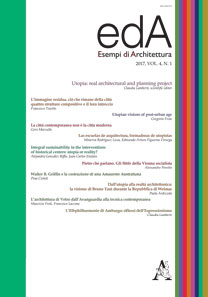Estratto da
ESEMPI DI ARCHITETTURA
International Journal of Architecture and Engineering
Utopian visions of post-urban age
ESEMPI DI ARCHITETTURA
International Journal of Architecture and Engineering
Utopian visions of post-urban age

The world utopia, defined by Thomas More in 1516, describes an ideal state, based on principles of economic and juridical equality. This essay wants to display a visual and iconic influence of utopian visions in architecture. The prophetical value in the Tables of Urbino, Baltimore and Berlin shows as ‘the copy preceded the original’ and ‘the fiction anticipated the reality’ (Régis Debray). There is a logical relation between the Utopia of Renaissance and twentieth century. As says Colin Rowe: “The fact there is or there was a deep and utopian impulse in modern architecture it’s undeniable. In fact as drawing tables of the Italian Renaissance also the same ones of first decade of twentieth century seems to be crammed with abstract images of cities” (Rowe, 1959). In Progetto e Utopia Manfredo Tafuri describes the propulsive and subversive rule of utopia in experimental works from the Age of Reason onwards. Dadaism, Surrealism, Futurism moving themselves on a radical criticism show the inner contradiction of middle-class and capitalistic world. In the postmodern architecture utopia becomes ironic quotation in which the rule of history is simultnaneously contradicted (Gregory, 2010). From apocalyptic background in literature and cinema, architectures of destruction show dystopic visions of tomorrow: the negative utopia in James Ballard; the description of catastrophic future of films like The Planet of Ape or Matrix or Inception; in the architecture of Lebbeus Wood, SITE Architects, Aldo Rossi, Francesco Venezia, Franco Purini, the semantic language of the dissonance and the fragment becomes reflection about the rule of the time and memory. In the age of the second modernity or reflective modernity some contemporary projects decline utopian vision in sustainable eu-topia -or pure utopia - in which the housing problem discovers new heuristic urban declensions.
| pagine: | 15-24 |
| DOI: | 10.4399/97888548991932 |
| data pubblicazione: | Giugno 2017 |
| editore: | Aracne |








